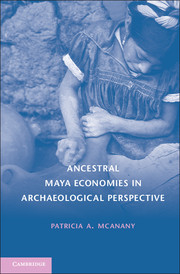Book contents
- Frontmatter
- Dedication
- Contents
- List of Figures
- Preface and Acknowledgments
- 1 The Materiality of Practice in Ancestral Maya Economies
- 2 Situating Maya Societies in Space and Time
- 3 Feeding a Hungry Landscape
- 4 Gendered Labor and Socially Constructed Space
- 5 Ritual Works: Monumental Architecture and Generative Schemes of Power
- 6 Naturalized Authority of the Royal Court
- 7 Social Identity and the Daily Practice of Artisan Production
- 8 Places, Practices, and People of Commerce
- 9 Flowery Speech of Maya Tributary Arrangements
- 10 Skeining the Threads
- References Cited
- Index
5 - Ritual Works: Monumental Architecture and Generative Schemes of Power
Published online by Cambridge University Press: 05 December 2014
- Frontmatter
- Dedication
- Contents
- List of Figures
- Preface and Acknowledgments
- 1 The Materiality of Practice in Ancestral Maya Economies
- 2 Situating Maya Societies in Space and Time
- 3 Feeding a Hungry Landscape
- 4 Gendered Labor and Socially Constructed Space
- 5 Ritual Works: Monumental Architecture and Generative Schemes of Power
- 6 Naturalized Authority of the Royal Court
- 7 Social Identity and the Daily Practice of Artisan Production
- 8 Places, Practices, and People of Commerce
- 9 Flowery Speech of Maya Tributary Arrangements
- 10 Skeining the Threads
- References Cited
- Index
Summary
There are few social processes in which the materiality of ritual practice is expressed more clearly than in the construction of monumental architecture. The mental image of a community of persons quarrying, transporting, and laying/packing stone or earthen fill in order to construct an edifice that is considered “monumental” even by twenty-first-century standards begets, to our secular mind, compelling questions. Who labored to build monuments so colossal and durable that even today they dominate the landscape of Mesoamerica? What were the identities of those who undertook the labor of construction – slaves, clients of wealthy royal families, or community members who volunteered their time and muscle to create a great temple to the gods? How were Maya pyramidal temples built and rebuilt? Some pyramidal temples contain tombs – afterlife “residences” of persons of renown – others don't. Some temples were built in a single-episode and massive construction event but most consist of “onion-skin” constructions, indicating that the ongoing practice of monumentalizing perhaps was as important as the finished edifice. Since most face onto large, open plazas, what purpose were these soaring structures meant to serve? Were they theaters of power – icons of community identity, shrines to tutelary deities, solar observatories – or simply funerary shrines to dead dynasts? Once constructed, how did these imposing edifices alter daily practice much less social relations?
- Type
- Chapter
- Information
- Ancestral Maya Economies in Archaeological Perspective , pp. 141 - 157Publisher: Cambridge University PressPrint publication year: 2010

